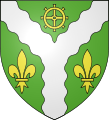Pall (heraldry)

A pall (or pairle) in heraldry and vexillology is a Y-shaped charge, normally having its arms in the three corners of the shield. An example of a pall placed horizontally (fesswise) is the green portion of the South African national flag.[1][2]

A pall that stops short of the shield's edges and that has pointed ends to its three limbs is called a shakefork, although some heraldic sources do not make a distinction between a pall and a shakefork.[3][2] A pall standing upside down is named pall reversed.[3]
An ecclesiastical pall on a shield, or pallium, is the heraldic indicator of archbishoprics.[2] These palls usually have a lower limb that stops short of the bottom of the shield with a fringe.[3]
Palls can also be modified with heraldic lines.[4] One example is the coat of Saint-Wandrille-Rançon.[5]
Gallery
- Arms of the Earl of Glencairn, chief of Clan Cunningham: Argent, a shakefork sable
- Arms of the town of Saint-Wandrille-Rançon:
Vert, a pall wavy Argent accompanied in chief by one mill wheel Or and flanked by two fleurs-de-lys of the same. - Arms of the city of Khabarovsk
- Seal of Shanghai Municipal Council, Shanghai International Settlement
References
- ^ Brownell, Frederick Gordon (May 2011). "Flagging the "new" South Africa, 1910-2010". Historia. pp. 42–62. Retrieved 31 December 2023.
- ^ a b c Fox-Davies, Arthur Charles (1904). The Art of Heraldry: An Encyclopedia of Armory. London: T.C. & E.C. Jack – via Internet Archive.
- ^ a b c Gough, Henry; Parker, James (1894). A Glossary of Terms Used in Heraldry (New ed.). Oxford and London: J. Parker and Co. p. 112.
- ^ Woodward, John; Burnett, George (1892) [originally published 1884]. Woodward's a treatise on heraldry, British and foreign: with English and French glossaries. Edinburgh: W. & A. B. Johnson. ISBN 0-7153-4464-1. LCCN 02020303.
- ^ "Histoire". Mairie de Rives-en-Seine (in French). Retrieved 31 December 2023.
External links
- . Encyclopædia Britannica. Vol. 20 (11th ed.). 1911. p. 635.










